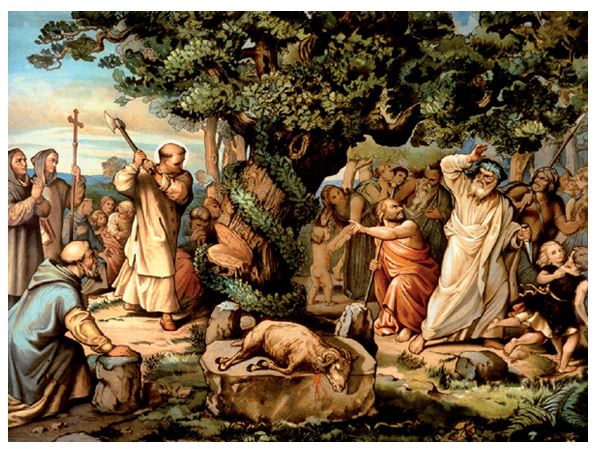
More classic art masterpieces used as illustrations
TL;DR: Boniface’s bold act of cutting down a sacred oak tree showed God’s power over false gods. It was a power encounter that advanced Christianity in early Germany. It illustrates how divine demonstrations can complement reasoned truth encounters in spreading the Gospel. The page includes reflection questions and an acrostic on the name BONIFACE.

Evangelism efforts often center on imparting Bible content. This is done through preaching, home Bible studies, one-on-one encounters, pamphlet dissemination, distribution of Scripture portions and entire Bibles, and JESUS film showings. In these "truth encounters," Gospel truths confront satanic lies with reasoned arguments.
From time to time, though, God also powerfully intervenes in this world in ways that demonstrate His ultimate sovereignty over all things. That's what He did on Mt. Carmel in the showdown between Elijah and the prophets of Baal (1 Kings 18). Sometimes, an event like that opens unbelievers' eyes as to who God Almighty is. In this way, tt can become an evangelistic event that draws people to God.
Those episodes in which unbelievers witness God's powerful hand at work are called "power encounters." Such power encounters happened periodically in Biblical times. Think, for instance, of Daniel in the lion's den or of Jesus casting out demons.
Divine power encounters did not fade away after the First Century. They have continued to happen throughout the history of world evangelism. They have included special protection from evil forces, survival of fierce persecution, healing, change of weather, and even nonbelievers having dreams and visions.
One evangelistic power encounter in the early 700s involved a missionary named Boniface. Boniface had entered the ministry in his native England and became a scholar and a teacher. It was a successful and safe life. Then, he felt a calling to cross-cultural evangelism. So, he was sent as a missionary to unevangelized central Germany.
Initially, Boniface had little success in turning people from their pagan religions to faith in Jesus. Even those who expressed some interest seemed reluctant to completely move away from their traditional religious beliefs. Finally, Boniface felt led to do something extraordinary.
One day, Boniface announced that he was going to cut down Donar's Oak (also known as Thor's Oak or Jove's Oak) near Geismar. That tree had been dedicated to Thor, the god of thunder and of war. Such sacred trees can be found even today where people follow ancient animistic religions. The audacious act of cutting down a tree consecrated to Thor might demonstrate his powerlessness and reveal to the people they had been worshiping a false god.
On the announced day, a crowd of pagans gathered at the tree, confident that Thor would show his power. Perhaps they thought that Thor would strike down this brash foreigner. At any rate, Boniface began chopping at the trunk of that tree with his ax. Wood chips began to fly. The pagans waited for Thor to do something, but nothing happened. Nothing. Then, they watched as the tree came crashing down.
Legend has it that Boniface used lumber from that tree to build a chapel. We don't know if that part of Boniface's story is true. We do know, however, that this power encounter marked a noteworthy turning point in the evangelization of the Germanic peoples.
Many truth encounters would follow as the gospel spread across Germany. On that day, however, it was a power encounter that showed who was powerless and who was, indeed, as Moses said, "the God of gods" (Deuteronomy 10:17).
Truth encounters and power encounters have both played prominent roles in global Gospel outreach. Truth encounters involve the oral and written proclamation and teaching of Gospel truths. Power encounters demonstrate God's sovereignty over all things in extraordinary ways. The articulation of these two approaches was done by missiologists Charles Kraft, Paul Hiebert, and C. Peter Wagner.
A power encounter in the early 700s involved a missionary named Boniface. His brave act of cutting down a sacred oak tree dedicated to the pagan god Thor demonstrated God's power to Germanic tribal people. Power encounters like that one have sometimes initiated breakthroughs in cross-cultural evangelism efforts. Indeed, Boniface's actions represented a key moment in the spread of Christianity in Europe.
-- Howard Culbertson, hculbert@snu.edu
B – Boldly proclaimed the gospel to hostile tribes.
O – Overcame fear with unwavering faith.
N – Nurtured new believers with patient teaching.
I – Ignited a spiritual awakening in pagan lands.
F – Fearlessly confronted idolatry and superstition.
A – Accepted martyrdom for the cause of Christ.
C – Cultivated churches that spread God’s truth.
E – Endured hardship with steadfast devotion.
Eleven More Mini-Essays in the "Doing Missions Well" series